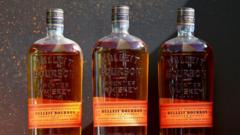What Caused the Rise and Fall of Kentucky Bourbon?

The Rise and Fall of Kentucky Bourbon: A Tale of Tradition, Trends, and Trade Wars
Kentucky bourbon has long been a symbol of American culture, deeply embedded in the fabric of the nation’s drinking heritage. With roots that stretch back to the 18th century, bourbon was officially recognized as a "distinctive product of the United States" by Congress in 1964. This designation only added to its allure, solidifying its status as an iconic beverage. However, as the economy continues to grapple with the ramifications of the COVID-19 pandemic and ongoing trade wars, the bourbon market is experiencing a significant downturn. The journey of this beloved spirit—from booming sales to precarious futures—offers insights into the complexities of consumer behavior, economic pressures, and the cyclical nature of trends in the alcoholic beverage industry.
The Historical Context of Bourbon
Bourbon’s history is rich and nuanced, with its origins rooted in the early American frontier. Traditionally crafted from corn and aged in charred oak barrels, bourbon has become synonymous with Kentucky, where the majority of production occurs. Over the decades, bourbon has evolved from a rustic beverage to a sophisticated choice enjoyed by enthusiasts and casual drinkers alike. Its popularity surged in the early 21st century, particularly post-2008 recession, when consumers began to gravitate toward more affordable, quality spirits. This renewed interest set the stage for a bourbon renaissance that would last well into the next decade.
The Bourbon Renaissance: Factors Driving Growth
Between 2011 and 2020, global bourbon sales skyrocketed by 7%, more than tripling the growth rate of the prior decade. Several factors contributed to this boom:
- Affordability: Bourbon offered a good price point, making it accessible to bars and young drinkers.
- Collectibility: A significant change in Kentucky law in 2013 allowed for the resale of vintage bottles, creating a high-end collectibles market.
- Nostalgia: Media influences, like the television series "Mad Men," reignited interest in mid-century aesthetics and culture, further fueling bourbon’s appeal.
As bourbon distillers gained notoriety, some became quasi-celebrities in their own right, attracting attention and investment. Consumers began treating collectible bottles more like assets than mere beverages. This phenomenon led to a frenzied market where bourbon was flipped for profit, reminiscent of stock trading.
The Impact of the Pandemic and Changing Consumer Trends
However, as with many market booms, this bourbon bubble was not destined to last. The onset of the COVID-19 pandemic had a drastic effect on the alcohol market, particularly on bourbon sales. Lockdowns and social distancing measures led to a significant drop in bar sales, a primary channel for bourbon consumption. Furthermore, inflation has prompted many consumers to seek out cheaper alternatives, particularly among younger generations. Gen-Z drinkers, for instance, are reported to consume less alcohol compared to their predecessors, indicating a cultural shift in drinking habits.
Economic Pressures and Trade Wars
Adding to the woes of the bourbon industry are the economic pressures stemming from ongoing trade wars and tariffs. The global tariffs imposed during President Donald Trump’s administration have had a detrimental effect on U.S. goods, including Kentucky bourbon. The EU's retaliatory tariffs and Canada’s decision to halt imports of American alcoholic beverages have exacerbated the situation. These moves directly impact the local bourbon economy, which has already been struggling in the wake of the pandemic.
The Consequences: Sales Decline and Bankruptcy
The combination of these factors has led to a notable decline in bourbon sales, with projections estimating a slowdown of just 2% from 2021 to 2024. Major brands like Diageo and Campari have reported significant drops in sales, leading to layoffs and closures. For instance, sales of Bulleit bourbon decreased by 7.3%, while Wild Turkey saw an 8.1% decline. With large, international brands likely able to endure these economic challenges, smaller distilleries are facing a more precarious future. The recent Chapter 11 bankruptcy filing by LMD Holdings and the closure of a barrel-making plant by Jack Daniel’s parent company highlight the fragility of the industry.
Innovation Amidst Adversity
Despite these challenges, history demonstrates that adversity can spur innovation. The Scotch whiskey industry, for example, transformed itself during periods of low sales by aging excess inventory, leading to the premium market we see today. Similarly, local distilleries in Canada have begun experimenting with bourbon-making techniques, adapting to changes in consumer demand while also capitalizing on the current trade climate.
The Future of Bourbon: What Lies Ahead?
As we look to the future, the bourbon industry faces a crossroads. The economic pressures from tariffs and shifting consumer preferences present significant challenges. However, the potential for innovation remains. Distillers may need to rethink their strategies, focusing on quality over quantity and developing unique offerings that appeal to a changing demographic. With a renewed focus on craft and authenticity, bourbon can carve out a new niche in the competitive spirits market.
Conclusion: Embracing Change in the Bourbon Industry
The journey of Kentucky bourbon is a fascinating reflection of American culture, showcasing how traditions evolve in response to economic, social, and political forces. As the bourbon industry continues to navigate the complexities of the current landscape, it remains essential for distillers to adapt and innovate. By embracing change and focusing on quality, the bourbon market can find a path toward recovery and growth.
Frequently Asked Questions
What is Kentucky bourbon?
Kentucky bourbon is a type of American whiskey that must be made primarily from corn and aged in charred oak barrels. It has a rich history and is recognized as a distinctive product of the United States.
How has the pandemic affected bourbon sales?
The COVID-19 pandemic has significantly impacted bourbon sales due to lockdowns and a decrease in bar consumption. Many consumers have shifted towards more affordable alcohol options, leading to declining sales.
What are the current challenges facing the bourbon industry?
Current challenges include economic pressures from tariffs, changing consumer preferences, and an oversupply of bourbon due to the industry's previous growth spurt. Many small distilleries are particularly vulnerable to these market conditions.
As we reflect on the storied past and uncertain future of Kentucky bourbon, it raises an important question: How will this iconic spirit adapt to survive in a changing world? #KentuckyBourbon #SpiritsIndustry #Innovation
Published: 2025-08-10 00:45:26 | Category: world



